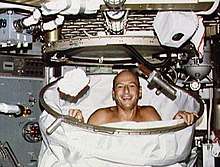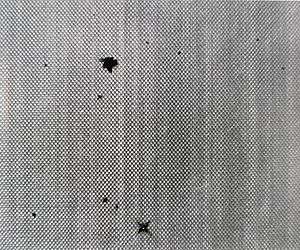Beta cloth
.jpg)

Beta cloth is a type of fireproof silica fiber cloth used in the manufacture of Apollo/Skylab A7L space suits, the Apollo Thermal Micrometeoroid Garment, the McDivitt Purse,[1] and in other specialized applications.
Beta cloth consists of fine woven silica fiber, similar to fiberglass. The resulting fabric will not burn, and will melt only at temperatures exceeding 650 °C (1,200 °F). To reduce its tendency to crease or tear when manipulated, and to increase durability, the fibers are coated with Teflon.
A tight weave of Beta cloth makes it more durable against atomic oxygen exposure.[2] Its ability to resist atomic oxygen exposure makes it commonly used as the outer-most layer in multi-layer insulation for space, and it was used significantly on the Space Shuttle and the International Space Station.[3]
It was implemented in NASA space suits after the deadly 1967 Apollo 1 launch pad fire, in which the astronauts' nylon suits burned through. After the fire, NASA demanded any potentially flammable materials were to be removed from both the spacecraft and space suits. Beta cloth was developed by a Manned Spacecraft Center team led by Frederick S. Dawn and including Matthew I. Radnofsky working with the Owens-Corning and DuPont companies.
Where additional wear resistance was needed, external patches of Chromel-R metallic cloth were used.[4]
Beta cloth was used as the material for the Skylab shower enclosure.[5]
The interior of the Space Shuttle payload bay was almost completely covered with Beta cloth.[6] This helps protect while staying open for weeks at a time in space.[7]
Micrometeroid impact on Beta cloth

See also
References
- ↑ Lotzmann, Ulrich (2 September 2015). "Temporary Stowage Bag - McDivitt Purse". Lunar Surface Journal. Apollo 12. Retrieved 9 May 2016.
- ↑
- ↑ "BA 500BC / CF500 F (Beta Cloth, Beta Fabric)". bronaerotech.com. Retrieved 2018-03-04.
- ↑ "New Apollo is to have fireproof cabin materials and spacesuits". Popular Science. November 1967. p. 98.
- ↑ "part3b". history.nasa.gov. Retrieved 2017-01-19.
- ↑
- ↑
- ↑ "BA 500BC / CF500 F (Beta Cloth, Beta Fabric)". bronaerotech.com. Retrieved 2018-03-04.
- Koontz; et al. (1993). "NASA Technical Memorandum 104748" (PDF). NASA.
External links
| Wikimedia Commons has media related to Beta cloth. |


.svg.png)
